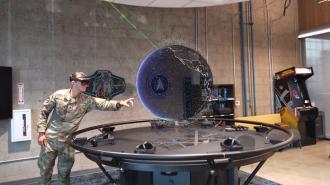Space Force pays Microsoft $20 million for a space simulator
Microsoft is building an advanced space simulator for the US Space Force, giving its members a way to immerse themselves in the off-world environment they’re sworn to defend.
“Picking up a headset and being able to visually interact with the planet and satellites and understand space more in depth was mind-blowing,” said 1st Lt. Jordan Savage, from the Space Systems Command’s Information Mobility Branch, after using the tech.
The challenge: Today’s military conflicts play out on land, in the sky, and at sea, but space could be the battlefield of the future — as the US increasingly relies on satellites for both civilian and military life, the nation’s adversaries are exploring more ways to attack the spacecraft.
“The threats that we face to our on-orbit capabilities from our strategic competitors [have] grown substantially … We’re seeing satellites that actually can grab another satellite, grapple with it, and pull it out of its operational orbit,” General B. Chance Saltzman, chief of space operation for the Space Force, told CNBC in 2023.
“I3E establishes an immersive environment to train, prepare, and enhance the mission of Guardians.”
Steve Kitay
What’s new? The Space Force was specifically established to defend America’s interests in space, and to help its service members, known as “Guardians,” meet that challenge, it is giving Microsoft $19.8 million to fully develop a space simulator it prototyped for the military in 2023.
Guardians can enter this digital world, known as the “Integrated, Immersive, Intelligent Environment” (I3E), using Microsoft’s HoloLens 2 hardware. They can then run simulations, model satellite behavior, and more in virtual or mixed reality.
“I3E establishes an immersive environment to train, prepare, and enhance the mission of Guardians for current and future space-based scenarios,” wrote Steve Kitay, senior director of Azure Space at Microsoft, in a blog post.
“I’m blown away watching our young Guardians interact with the cutting-edge technology.”
Col. Richard Kniseley
Looking ahead: The nearly $20 million contract is for one year of I3E development and includes an option for an additional three years. The space simulator is currently accessible at a Space Force facility in Los Angeles, but will eventually be made available remotely through a secure virtual desktop.
“Continuing the development and deployment of the I3E is going to pay huge dividends for our Guardians,” said Col. Richard Kniseley, senior materiel leader for the SSC’s Commercial Space Office.
“I’m blown away watching our young Guardians interact with the cutting-edge technology the I3E offers,” he continued. “Linking numerous sites together through the robust digital ecosystem provides an unrivaled experience to better understand the space domain.”
We’d love to hear from you! If you have a comment about this article or if you have a tip for a future Freethink story, please email us at [email protected].





